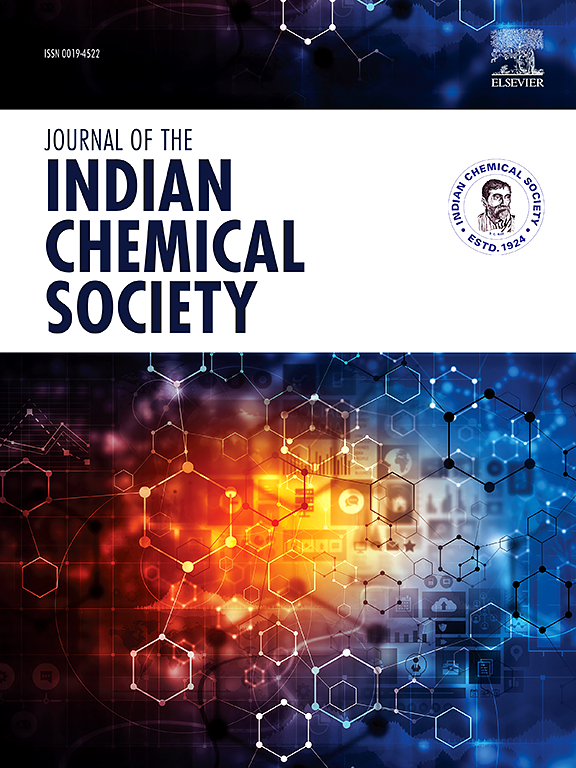Optimization of fermentation conditions for bioethanol production from oil palm trunk sap
IF 3.2
4区 化学
Q2 CHEMISTRY, MULTIDISCIPLINARY
引用次数: 0
Abstract
Oil palm trunk (OPT) sap, a waste product generated during the felling of Elaeis guineensis (E. guineensis) trees, has been identified as an underutilized resource with significant potential for sustainable bioethanol production. In this study, fermentation parameters were optimized to maximize bioethanol yield from felled E. guineensis OPT sap using Saccharomyces cerevisiae (S. cerevisiae) Kyokai no. 7. A combination of Plackett–Burman design (PBD), steepest ascent method, and Box–Behnken design (BBD) was employed to screen and optimize key variables, including temperature, initial pH, fermentation time, yeast extract, sodium chloride, ammonium sulfate, magnesium sulfate, peptone, urea, and corn steep liquor (CSL). Among these, initial pH, peptone, and CSL were identified as the most significant effects and were selected for further optimization. The fermentation process was conducted using a batch strategy to enhance productivity and simulate scalable operation. The optimal conditions were predicted by BBD with pH 6.50, peptone at 6.80 g/L, and CSL at 13.28 g/L, which resulted in a validated bioethanol yield of 0.4800 ± 0.0275 g/g and a validation accuracy of 94.12 %. These findings demonstrated the viability of felled E. guineensis OPT sap as a promising fermentation substrate, which has been largely overlooked in bioethanol research. The integration of sequential statistical optimization techniques enabled efficient fine–tuning of key parameters to approach theoretical conversion limits. Overall, this work supported the potential of felled E. guineensis OPT sap as a sustainable feedstock for bioethanol production and offers a foundation for process scaling, cost analysis, and further refinement through strain or co–substrate diversification.

油棕树干汁液生产生物乙醇发酵条件的优化
油棕树干(OPT)汁液是砍伐几内亚Elaeis guineensis (E. guineensis)树木过程中产生的废物,已被确定为一种未充分利用的资源,具有可持续生物乙醇生产的巨大潜力。本研究以酿酒酵母Kyokai no为原料,对采伐的几内亚棘球线虫OPT汁液的发酵参数进行优化,以最大限度地提高生物乙醇的产量。7. 采用Plackett-Burman设计(PBD)、最速上升法和Box-Behnken设计(BBD)对温度、初始pH、发酵时间、酵母浸膏、氯化钠、硫酸铵、硫酸镁、蛋白胨、尿素和玉米浸泡液(CSL)等关键变量进行筛选和优化。其中,初始pH、蛋白胨和CSL的影响最为显著,并对其进行进一步优化。发酵过程采用批量策略进行,以提高生产率和模拟可扩展操作。以BBD (pH 6.50)、蛋白胨(6.80 g/L)和CSL (13.28 g/L)为最佳条件,验证生物乙醇得率为0.4800±0.0275 g/g,验证精度为94.12%。这些发现证明了砍伐的几内亚棘球线虫OPT汁液作为一种有前途的发酵底物的可行性,这在生物乙醇研究中很大程度上被忽视了。序列统计优化技术的集成使关键参数的有效微调接近理论转换极限。总的来说,这项工作支持了砍伐的几内亚棘球线虫OPT汁液作为生物乙醇生产的可持续原料的潜力,并为工艺规模化、成本分析以及通过菌株或共底物多样化进一步改进提供了基础。
本文章由计算机程序翻译,如有差异,请以英文原文为准。
求助全文
约1分钟内获得全文
求助全文
来源期刊
CiteScore
3.50
自引率
7.70%
发文量
492
审稿时长
3-8 weeks
期刊介绍:
The Journal of the Indian Chemical Society publishes original, fundamental, theorical, experimental research work of highest quality in all areas of chemistry, biochemistry, medicinal chemistry, electrochemistry, agrochemistry, chemical engineering and technology, food chemistry, environmental chemistry, etc.

 求助内容:
求助内容: 应助结果提醒方式:
应助结果提醒方式:


